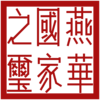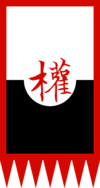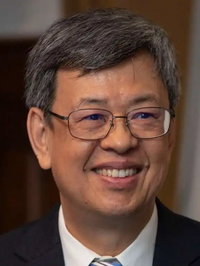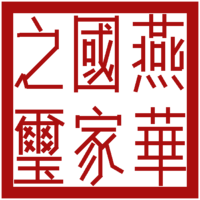President of Yingok
This article is incomplete because it is pending further input from participants, or it is a work-in-progress by one author. Please comment on this article's talk page to share your input, comments and questions. Note: To contribute to this article, you may need to seek help from the author(s) of this page. |
| President of the Fourth Republic of Yingok | |
|---|---|
| 燕國總統 jin3 gwok3 zung2 tung2 | |
 | |
 | |
| Executive branch of the Yingok Government | |
| Style | Mr President (informal) His Excellency (diplomatic) |
| Status | Head of state Head of government Commander-in-chief |
| Member of | Cabinet X |
| Residence | Jibun Palace |
| Seat | Dongsing, Yingok |
| Appointer | Popular vote |
| Term length | six years, renewable twice |
| Constituting instrument | Constitution of Yingok |
| Precursor | Monarch |
| Inaugural holder | Ho Siyat |
| Formation | 16 July 1896; 127 years ago (First Republic) 19 April 1974; 50 years ago (Fourth Republic) |
| Deputy | Vice President |
| Salary | $400,000 per year[1] |
| Website | yingokpresident.gov.yn |
The President of Yingok, officially the President of the Fourth Republic of Yingok (Yinese: 燕國總統, Jinping: jin3 gwok3 zung2 tung2) is the head of state and head of government of Yingok, and the commander-in-chief of the Yinese Defence Force. The President is elected every six years by popular vote, and is eligible for a maximum of three terms in office. The president is responsible for enforcing national policies and laws, appointing government officials such as ministers, judges, and civil servants. The president also represents the country in international affairs. The President resides in the Jibun Palace in Dongsing, and is advised by his cabinet of ministers.
The power of the presidency has fluctuated substantially since the first president, Ho Siyat, in 1896. In recent years, allegations of corruption and misuse of power have plagued presidents and their respective administration. This has led to public discontent and protests, with citizens calling for greater transparency and accountability in government. There have been several high-profile corruption cases involving the President and their close associates, leading to calls for investigations and reforms. This had led to the resignation, impeachment and occasionally imprisonment of former Yinese presidents including TBD.
The current president is Yeung Kapkaa who succeeded Zeng Ying in 2022 who served the remaining months of X's terms following his resignation after several major scandals involving corruption and embezzlement came to light. In total, there have been 16 presidents including the incumbent, with 7 of them belonging to the Fourth Republic.
History
TBA
Election
TBA
Powers
TBA
Criminal responsibility and impeachment
TBA
Succession
TBA
Pay and offical residence
TBA
List of presidents
Political parties: N A NC SL K C CC
| Nº | Portrait | Name (Birth–Death) |
Term of office | Time in office | Political party | Notes | |
|---|---|---|---|---|---|---|---|
| 1 | 
|
Ho Siyat (8 February 1855–2 November 1900) |
16 July 1896 | 2 November 1900† | 4 years, 109 days | Kongwotong | Founder and first President of Yingok, oversaw the ratification of the first Constitution of Yingok. However, he was assassinated in 1900 in a shootout with local anti-government militias during a visit to Wongzen.[2] |
| — | |||||||
| 2 | 
|
Baak Yingman (27 August 1868–13 March 1922) |
2 November 1900 | 17 September 1911 | 10 years, 319 days | Kongwotong | Served as Vice President under Ho, he became acting president following his assassination and crackdowned on possible anti-government and dissenting factions. In 1905, he dissolved the National Diet and proclaimed the birth of the Empire of Yingok. The Union-Imperial War from 1908 to 1911 eventually saw the deposition and imprisonment of Baak and the restoration of the Republic.[3] |
| — | |||||||
| 3 | 
|
Gong Yeunwai (19 May 1862–30 October 1938) |
27 November 1913 | 1 December 1920 | 7 years, 4 days | Kongchangtong | Was widely considered a weak president. During his tenure, the Second Republic struggled and often failed to maintain control over potential breakaway states and warlord factions.[4] |
| 1913 | |||||||
| 4 | X | Lo Waijing (3 July 1859–16 June 1941) |
1 December 1920 | 16 June 1941† | 20 years, 197 days | Kwokmuntong | Aimed to strengthen the Yinese economy during his 20-year tenure, specifically with foreign trade and investement.[5] However, his efforts were hindered by the continued dominance of warlords. The Six-Year Plan for Economic Reconstruction which aiming to address the economic challenges within the country itself was also introduced. However, it was met with very limited success.[6] He also oversaw the Yinese Midlands War and Yingok-Long War which, along with most of the day-to-day governance, he left mainly to his vice president and cabinet duet to his old age. He would later die of a stroke in June 1941, ending his reign.[7] |
| 1920, 1927, 1934 | |||||||
| 5 | X | Fong Yunwai (14 March 1882–1 April 1942) |
16 June 1941 | 1 April 1942† | 289 days | Kwokmuntong | Served as Vice President of Lo Waijing and became acting president soon after his death. However, he would be later assassinated in a bombing by pro-monarchist terrorists.[8] |
| 1941 | |||||||
| 6 | X | Fung Hokgong Acting (23 September 1877–8 January 1943) |
6 April 1942 | 27 November 1942 | 235 days | Kongchangtong | Previously Chancellor of the National Diet, he was sworn in as acting president 2 days after Fong's assassination and martial law was declared. Curfews were imposed in major cities, and the government launched a crackdown on suspected dissidents and extremist groups.[8] |
| — | |||||||
| 7 | 
|
Hong Bokngai (22 December 1904–15 April 1982) |
27 November 1942 | 2 January 1956 | 13 years, 36 days | Confederacy Coalition | Continued his predecessor's crackdowns while also beginning several ineffective moderate economic and social reforms.[8] Hong also attempted to implement several programmes to improve social welfare, healthcare, and education. This was helped along by a fragile peace between political factions that was maintained by the government under Hong.[9] Hong proposed reforms to the constitution which was eventually agreed on in February of 1943 by the National Diet. The revision of the Constitution took place over numerous months. Eventually, by September, the revised constitution was finalised and ratified by the National Diet on the 30th.[10] The Third Republic was proclaimed as a result. Hong began to assert dominance over the warlords and breakaway states during his reign of the Third Republic, which resulted in the end of the northeastern Hakul cliques as well as the reintegration of Sikhoy.[11] |
| 1942, 1949 | |||||||
| 8 | X | Siu Gunyu (13 August 1895–27 February 1974) |
2 January 1956 | 2 January 1962 | 6 years, 0 days | Kwokmuntong | Passed the Haksaan-Fui Reorganisation Act which annexed all of Yingok's satellite territories.[12] |
| 1955 | |||||||
| 9 | X | Yin Kyun (6 November 1912–18 May 1975) |
2 January 1962 | 18 May 1975† | 13 years, 136 days | Weikuntong | Oversaw much of the Yinese Civil War due to emergency powers allowed by the existence of the conflict. He died of smallpox while in office.[citation needed] |
| 1961 | |||||||
| X | X | TBA | TBA | TBA | TBA | TBA | TBA |
| TBA | |||||||
Lists relating to the presidents of Yingok
TBA
See Also
References
- ↑ "What is the Salary of Goverment Officials?". South Yinese Post. Retrieved 12 July 2015.
- ↑ Wong, Meng (1978). 何士日:第一共和國建築師 [Ho Siyat: Architect of the First Republic]. Yutzhau University Publishing. Retrieved 24 March 2010.
- ↑ Ng, Kate (1991). "The Crimes of Baak Yingman". Political Review of Yingok. 4 (2): 120–135. Retrieved 25 June 2018.
- ↑ Gwok, Jim (1983). "Warlordism: An Analysis of the Yinese Political Landscape". Yingok Historical Society. 12 (3): 67–92. Retrieved 29 November 2018.
- ↑ Ng, Jik (27 November 1927). "盧偉靜連任" [Lo Waijing Re-Elected]. Dongsing Gazette. Archived 21 March 1999. Retrieved 8 July 2012.
- ↑ Man, Paangsing (18 December 1930). "總統宣經濟計劃" [President Announces Economic Plan]. Samlong Bellman. Archived 22 May 1998. Retrieved 30 July 2016.
- ↑ So, Ying (18 June 1941). "盧偉靜過世,方潤威宣代理總統" [Lo Waijing Dead, Fong Yunwai Declared Acting President]. Dongsing Gazette. Archived 15 October 1998. Retrieved 4 February 2012.
- ↑ 8.0 8.1 8.2 Norred, Oddmund (1992). "The Aftermath of the Assassinations of 1942". Abarian Studies. 60 (1): 67–89.
- ↑ Wen, Gitwing (2000). "The Fragmentation of the Second Republic: An Analysis of Breakaway States". Yingok Cultural Heritage Foundation. Retrieved 28 February 2019.
- ↑ Ng, Thomas (1997). "The 1943 Constitutional Reforms in Yingok". Abarian Studies. 61 (2): 123–145. Retrieved 8 April 2012.
- ↑ Dong, Alfred (2003). "The Presidency of Hong Bokngai". Yingok Cultural Heritage Foundation. Retrieved 19 March 2017.
- ↑ "第三共和國的崛起". Retrieved 4 June 2016.

